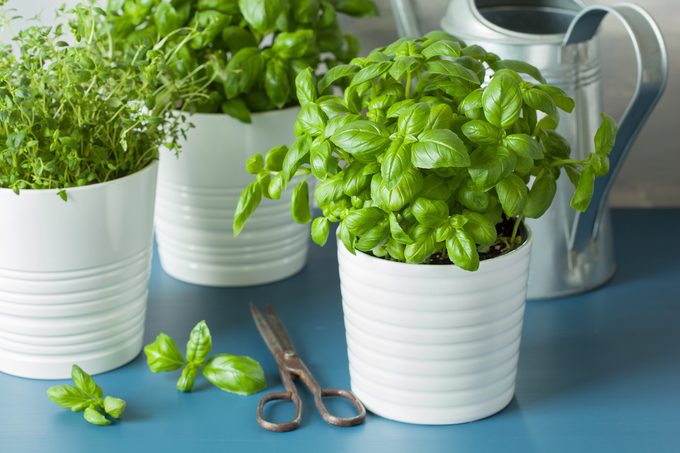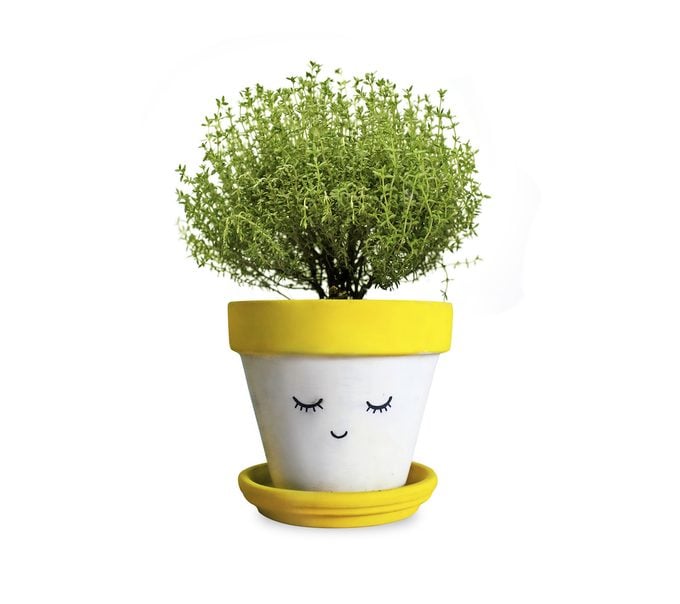Create a Windowsill Herb Garden
Updated: Jan. 11, 2021
Follow these easy directions to get the most out of a windowsill herb garden, including how to choose herbs, and watering, light and temperature tips.

Having trouble letting go of those gardening gloves? Keep your green thumb busy with a windowsill herb garden this winter. I am going to let you in on a little secret: Having a buffet of fresh herbs such as basil, oregano and parsley is the easiest way to elevate your cooking and add bright flavor to your food. It’s also cost-effective because most herb plants are readily available and inexpensive—plus they produce new growth for months.
Choose Plants for a Windowsill Herb Garden
Herbs like basil, parsley and chives can easily be grown from seed, but for an instant indoor garden, buy plants from your local supermarket or garden center. Certain types—mint, thyme and rosemary—may take months to size up when grown from seed, so starting with good-sized specimens means you get to start enjoying herbs right away.
5 Best Herbs to Grow Indoors
Many culinary herbs grow well indoors, but plant the ones you use the most.
Parsley. This is a great choice for a sunny windowsill where no supplemental lighting is available, as it can produce a good harvest in less light. Parsley adds bright flavor to pastas, soups and salads.
Oregano. It is a sun lover and offers the best harvest when given plenty of light. In spring and summer, a bright south-facing window should provide enough light. In autumn and winter, add a grow light.
Thyme. The tiny leaves of thyme add big flavor to soups, stews and marinades. It’s also very easy to grow on a south- or east-facing windowsill. For a flavor twist, plant a pot of lemon thyme.
Rosemary. Rosemary is a Mediterranean herb that needs full sun and well-drained soil. It’s hard to replicate these conditions indoors but I’ve had success by supplementing with a grow light. I don’t overwater, but I do mist daily (keep a decorative hand sprayer on the windowsill as a reminder).
Basil. The spicy-sweet flavor and aroma of basil have made it a top kitchen herb. Harvest often, pinching back to a fresh set of leaves to stimulate new growth, and try out this basil salt recipe.
Tips for Setting Up a Windowsill Herb Garden
Do install a little ledge or shelf under your window if you don’t already have one.
Don’t put too much weight on the shelf. Keep in mind that plants and pots get heavier when watered.
Do check the temperature next to your window. While temperature needs vary from one plant to the next, you’ll want to try to keep in the 70°-75° range. If it gets cool, you might have to rethink the placement.
Don’t put your plants directly over a heating vent.
Do make sure your windowsill garden gets enough sunlight and turn the herb pots often to encourage upward growth.
Don’t fret if your first plant dies a quick death. Tweak your approach and then try again.
If you’re not sure windowsill gardening is for you, start with microgreens. They’re easy to grow, and you can harvest many of them in as little as a week. And they’re nutritious in a salad!
Next, learn how to grow a vertical herb garden in a shoe organizer.
Light for Windowsill Herb Gardens
Providing enough light is the biggest challenge when growing herbs indoors, especially in winter. Sunshine is most plants’ best friend, so pick a window with a minimum of 5-6 hours of sunlight a day for best results. Many common herbs originate from warm regions like the Mediterranean and require plenty of light for healthy growth and large yields.
“You can sometimes get away with growing easy herbs indoors in spring and summer months without grow lights if you are lucky enough to have a big, unobstructed south-facing window,” says Leslie F. Halleck, author of Gardening Under Lights, Plant Parenting, and Tiny Plants (to be released March 2021), noting that even a bright windowsill may not provide enough light for sun lovers like oregano and basil. “I usually recommend sticking with part-sun, part-shade herbs like mint, parsley and cilantro indoors.”
Since the goal of growing herbs indoors is to get a good harvest, Leslie suggests using grow lights to supplement natural light or to provide all light if growing away from a window. “By using one or two full-spectrum LED grow lamps in the 20-to-45-watt range, you can provide adequate light for your herbs,” she says. “If you are providing only supplemental light, run the grow lamps for three to six hours a day; if you are providing all the light, run them for 12 to 16 hours a day.”
Don’t have a sunny window? Try an AeroGarden—Here’s our review.
Watering Your Windowsill Herb Garden
Herbs need enough water to keep their roots adequately moist, but not so much that they rot. My kitchen windowsill is the most convenient spot to grow herbs because it lets me keep a close eye on soil moisture. Not sure when to water? Stick a finger in the soil. If it’s dry, water. If it’s moist, don’t water.
Here are 6 products that make watering plants easy.
Troubleshooting Tips and Tricks
Before you find an indoor home for your windowsill herb garden, do a quick scan. “Keep plants away from heating elements or vents that could cause plants to dry out too quickly,” says Leslie, who also mentions that low indoor humidity in winter can be a challenge. Place pots over a drip tray filled with pebbles and water to easily increase humidity, especially in winter.
It’s also a good idea to monitor for pests. “Spider mites, whiteflies, fungus gnats and aphids can be a problem, especially if herbs are stressed and not getting enough light or water,” Leslie says. Here’s how to get rid of indoor plant bugs.
Harvest Herbs Often
Never shy away from harvesting. The general rule is the more you pick, the more you get. Regular clipping encourages bushy growth, which means a bigger harvest.
Because I use certain herbs, like basil, a lot, I have been guilty of over-harvesting from my plants. If your herbs are starting to look sparse, that’s OK! Just buy a new plant. I like to keep two or three basil plants on my windowsill so I never run out of aromatic basil for my pasta sauces.
Next, learn how to dry and store garden herbs.

